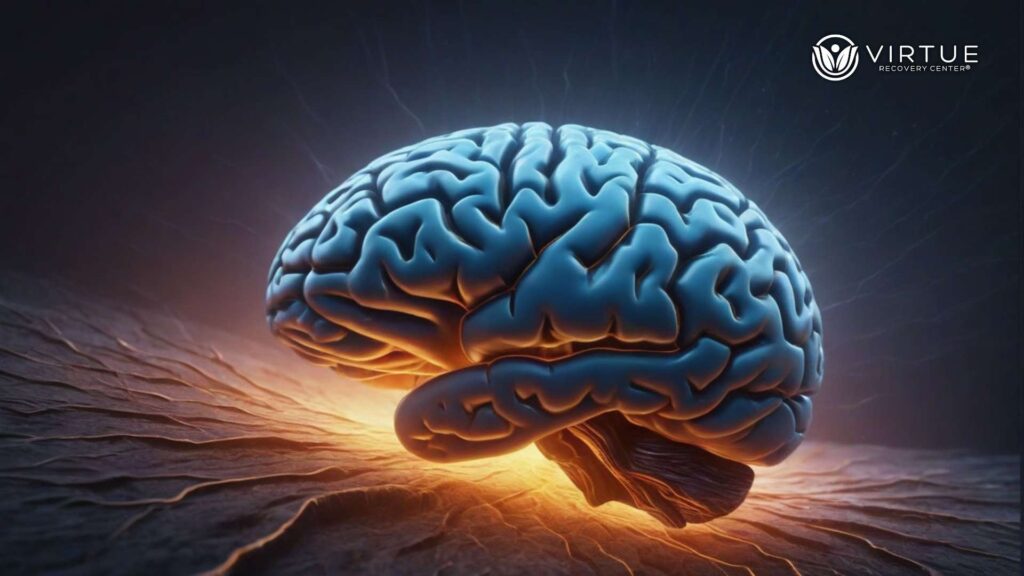Addiction is a complex and chronic brain disease that profoundly alters brain function and structure. This article explores the intricate relationship between the brain and addiction, focusing on how substance use changes the brain’s chemistry, structure, and overall function. We delve into the role of dopamine in addiction, the impact of different drugs on various parts of the brain, and the critical importance of effective treatment approaches such as behavioral therapies and medication-assisted treatment.
Key Takeaways
- Addiction fundamentally changes the brain’s structure and function, leading to compulsive drug use and difficulty in stopping the use of substances.
- Dopamine plays a crucial role in addiction by reinforcing pleasurable sensations associated with drug or alcohol use.
- Effective treatment, including behavioral therapies and medication-assisted treatment, is essential for managing addiction and supporting long-term recovery.
Introduction
Addiction is not just a bad habit or a moral failing—it is a chronic brain disease that significantly impacts how the brain functions. The National Institute on Drug Abuse (NIDA) defines addiction as a condition where a person cannot stop using a substance despite harmful consequences. This inability to quit stems from the profound changes that substance use causes in the brain. These changes affect how individuals feel pleasure, how they control impulses, and how they make decisions. In this article, we will explore some mind-blowing facts about how addiction affects the brain, the role of dopamine, and why effective treatment is crucial for recovery.
The Science of Addiction: How Drugs and Alcohol Affect the Brain
How Addiction Alters Brain Function
Addiction is recognized as a chronic brain disease because it changes the brain’s chemistry and structure in lasting ways. Drug use and alcohol use affect the brain’s natural balance of neurotransmitters, particularly dopamine, which plays a key role in the brain’s reward system. When someone uses drugs or alcohol, their brain releases large amounts of dopamine, creating feelings of pleasure and reinforcing the behavior of substance use. Over time, the brain adapts to these dopamine surges by reducing its natural production, leading to a need for more substances to achieve the same pleasurable effects. This cycle is what makes addiction so difficult to overcome—it fundamentally alters the way the brain functions.
The Role of Dopamine in Addiction
Dopamine is often called the “feel-good” neurotransmitter because it plays a significant role in how we experience pleasure. When we do something enjoyable, such as eating a favorite food or engaging in a hobby, our brain releases dopamine. However, substances of abuse, such as cocaine, heroin, and alcohol, cause the brain to release much higher levels of dopamine than natural rewards do. This massive release of dopamine not only creates intense feelings of pleasure but also reinforces the behavior of drug or alcohol use, making it more likely that the person will continue using the substance. Over time, this can lead to compulsive drug use, where the person feels driven to continue using the substance despite knowing the harm it causes.
Changes in Brain Structure Due to Addiction
Long-term addiction leads to significant changes in brain structure, particularly in areas responsible for decision-making, impulse control, and behavior regulation. Chronic substance use affects the brain’s prefrontal cortex, which is involved in planning, decision-making, and self-control. These changes can make it incredibly difficult for someone with an addiction to resist cravings or make rational decisions about their substance use. Additionally, brain imaging studies have shown that addiction can alter the brain’s reward system, making natural rewards less satisfying and further driving the cycle of substance use.
Mind-Blowing Facts About the Brain and Addiction
Fact 1: Addiction Changes the Brain in Lasting Ways
One of the most astonishing facts about addiction is that it causes lasting changes in the brain, even after a person stops using drugs or alcohol. Brain scans of individuals who have struggled with addiction show that some regions of the brain remain altered long after the last use of the substance. These changes can affect how a person experiences pleasure, how they handle stress, and their ability to make decisions. Understanding these changes is crucial for developing effective addiction treatment strategies.
Fact 2: Different Drugs Affect Different Parts of the Brain
Not all drugs of abuse affect the brain in the same way. For example, cocaine primarily affects the brain’s reward system by blocking the reuptake of dopamine, leading to an accumulation of the neurotransmitter in the brain. This results in intense feelings of euphoria but also increases the risk of addiction. On the other hand, heroin affects the brain’s opioid receptors, leading to pain relief and relaxation but also causing profound changes in brain function that contribute to compulsive drug use. Brain imaging studies have revealed that different drugs target specific areas of the brain, leading to unique patterns of addiction and brain damage.
Fact 3: The Brain’s Reward System is Hijacked by Drugs
One of the most significant ways that addiction affects the brain is by hijacking the brain’s natural reward system. The brain is wired to reward behaviors essential for survival, such as eating and socializing, by releasing dopamine. However, when someone uses drugs or alcohol, the brain releases dopamine at much higher levels than normal, creating an intense feeling of pleasure. This “hijacking” of the reward system leads to the brain prioritizing drug use over other activities, driving the cycle of addiction and making it incredibly difficult to stop using the substance.
Fact 4: Addiction is a Chronic Disease that Requires Long-Term Treatment
Another critical fact about addiction is that it is a chronic disease that often requires long-term treatment to manage effectively. Because addiction causes lasting changes in the brain, treatment must address both the physical and psychological aspects of the disease. Behavioral therapies, such as Cognitive Behavior Therapy (CBT) and medication-assisted treatment (MAT) are essential components of a comprehensive treatment plan. These treatments help individuals manage cravings, reduce the risk of relapse, and develop healthier coping mechanisms to replace substance use.
The Role of Effective Treatment in Managing Addiction
Behavioral Therapies and Cognitive Behavior Therapy (CBT)
Behavioral therapies, such as Cognitive Behavior Therapy (CBT), are critical in helping individuals understand and change the thoughts and behaviors that contribute to their addiction. CBT focuses on identifying and challenging cognitive distortions, developing healthier thinking patterns, and building coping skills to manage stress and cravings. By addressing the psychological aspects of addiction, CBT can help individuals reduce their dependence on substances and improve their overall mental health.
Medication-Assisted Treatment (MAT)
Medication-assisted treatment (MAT) combines medications with therapy to provide a comprehensive approach to addiction treatment. MAT is particularly effective in treating opioid and alcohol use disorders by reducing cravings and withdrawal symptoms, stabilizing brain chemistry, and helping individuals focus on their recovery. MAT is often used alongside behavioral therapies to provide a well-rounded treatment approach that addresses both the physical and psychological aspects of addiction.
The Importance of a Comprehensive Treatment Approach
Effective addiction treatment requires a comprehensive approach that includes both behavioral therapies and medication-assisted treatment. This approach addresses the full scope of addiction by targeting the brain changes caused by substance use, helping individuals develop healthier behaviors, and supporting long-term recovery. Relapse is a common part of the recovery process, but with the right treatment and support, individuals can overcome addiction and lead fulfilling, substance-free lives.
Conclusion
The relationship between the brain and addiction is complex and profound, with substance use causing significant changes in brain structure and function. Understanding these changes is crucial for developing effective treatment strategies and supporting individuals in their recovery journey. Addiction is a chronic brain disease that requires ongoing management and support, but with the right treatment, recovery is possible. If you or someone you know is struggling with addiction, contact Virtue Recovery Center at 866-461-3339 for help and guidance.
FAQs
What is the brain disease model of addiction?
The brain disease model of addiction views addiction as a chronic condition that changes the brain’s structure and function, leading to compulsive substance use and difficulty in stopping.
How does addiction change brain structure and function?
Addiction causes lasting changes in the brain, particularly in areas responsible for decision-making, impulse control, and behavior regulation. These changes make it challenging to stop using substances and increase the risk of relapse.
Why is dopamine important in the development of addiction?
Dopamine plays a crucial role in the brain’s reward system, reinforcing pleasurable behaviors associated with substance use. The release of dopamine during drug use creates intense feelings of pleasure, driving the cycle of addiction.
What are the long-term effects of drug use on the brain?
Long-term drug use can lead to significant changes in brain structure and function, affecting decision-making, impulse control, and the ability to experience pleasure from natural rewards.
What treatment approaches are practical for managing addiction?
effective treatment approaches for addiction include behavioral therapies, such as Cognitive Behavior Therapy (CBT) and medication-assisted treatment (MAT). These treatments help address both the psychological and physical aspects of addiction, supporting long-term recovery.
Resources
https://newsinhealth.nih.gov/2015/10/biology-addiction
https://nida.nih.gov/publications/drugs-brains-behavior-science-addiction/drugs-brain
https://www.helpguide.org/harvard/how-addiction-hijacks-the-brain.htm



























